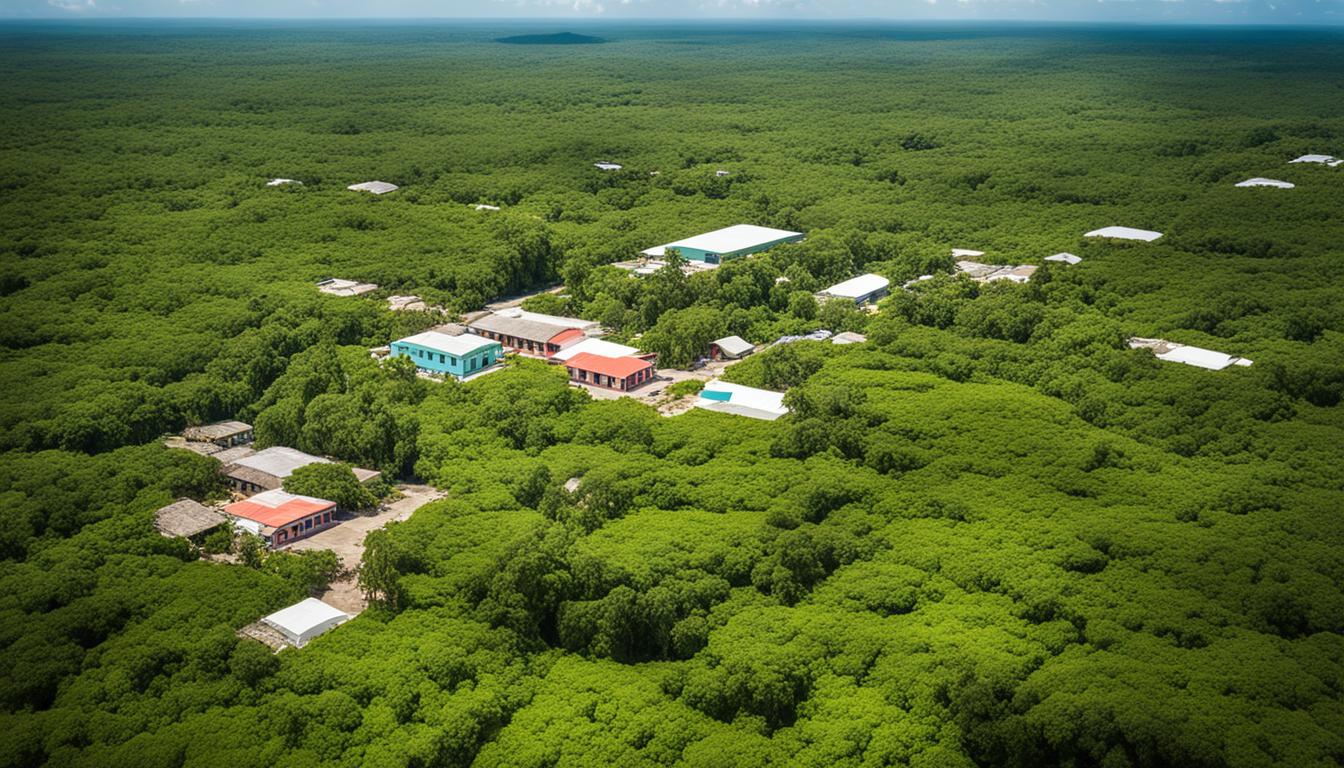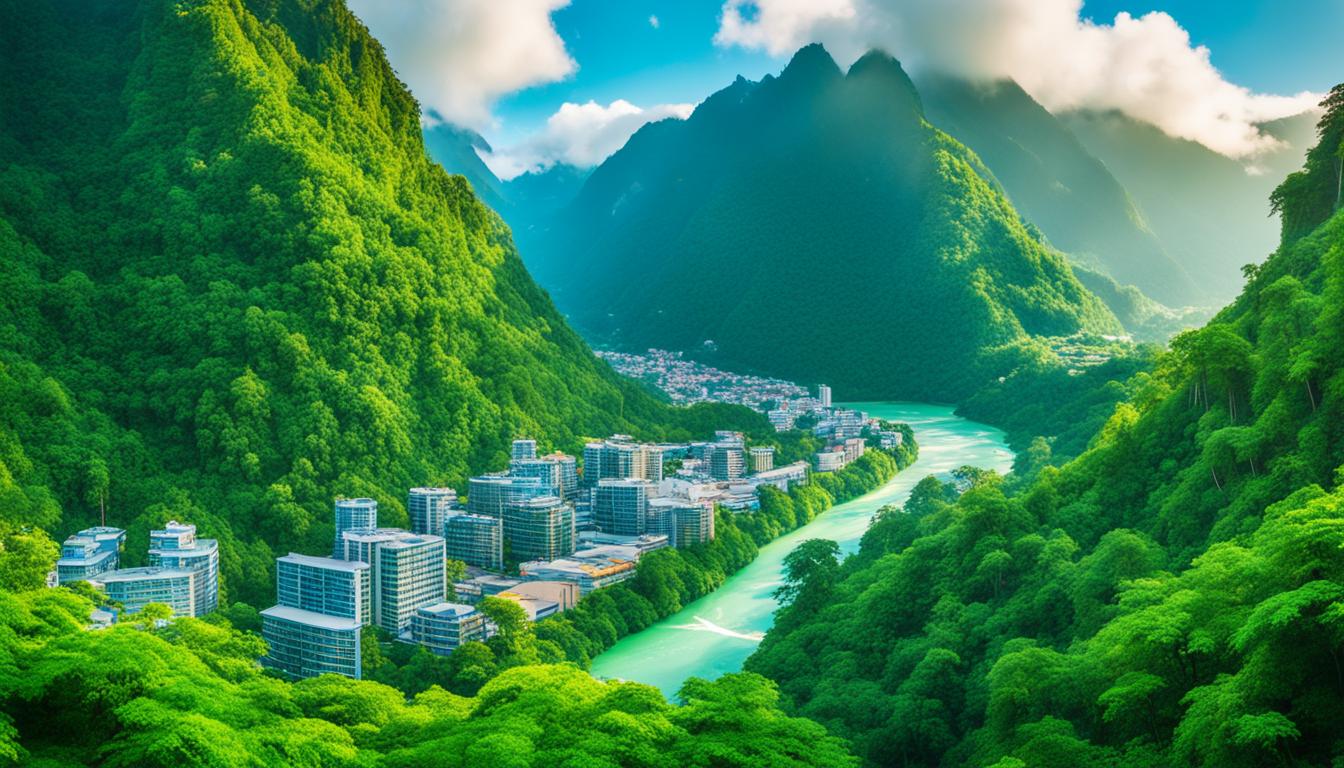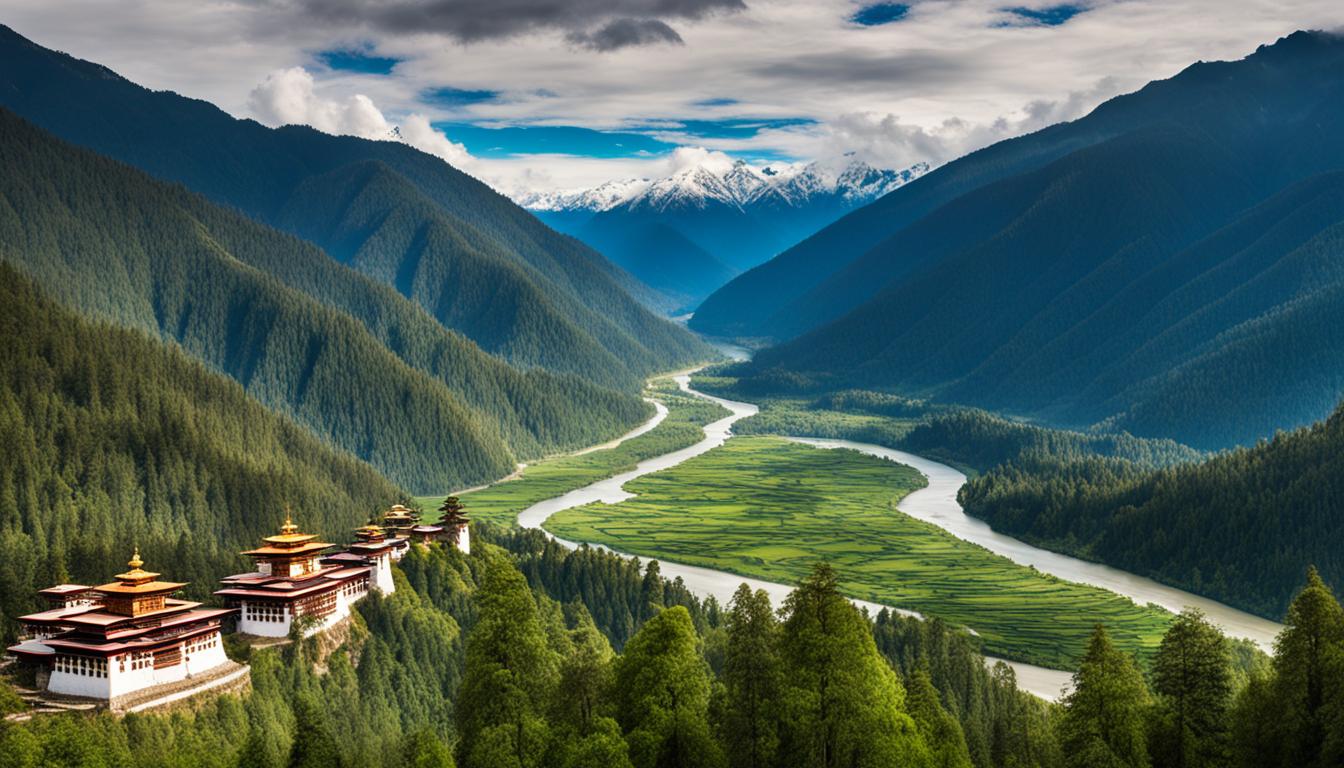Bhutan Biodiversity and the Built Environment
Welcome to our latest blog post, where we explore the fascinating world of Bhutan’s biodiversity and its intricate relationship with the built environment. Situated in the Eastern Himalayas, Bhutan is a treasure trove of diverse ecosystems and abundant wildlife. With its commitment to conservation, sustainable development, and eco-friendly architecture, Bhutan is setting an example for environmental sustainability and urban planning.
In this article, we will delve into the richness of Bhutan’s flora and fauna, the threats faced by its biodiversity, the conservation efforts in place, and the future challenges and actions needed to ensure the longevity of Bhutan’s natural heritage. We will also explore the benefits that Bhutan’s biodiversity brings to the country in terms of ecosystem services, economic opportunities, and cultural value.
So, join us on this journey to discover the harmonious coexistence of Bhutan’s biodiversity and built environment, and how it contributes to the country’s unique identity and sustainable future.
Key Takeaways:
- Bhutan is a global biodiversity hotspot with diverse ecosystems.
- The country’s rich biodiversity faces threats from land conversion, overexploitation, climate change, and forest fires.
- Bhutan has implemented conservation measures and established protected areas to safeguard its biodiversity.
- Green building practices in Bhutan have a long-standing history rooted in cultural and spiritual beliefs.
- Bhutan’s commitment to sustainable development is reflected in its green building initiatives and conservation strategies.
The Richness of Bhutan’s Flora and Fauna
Bhutan is renowned for the incredible biodiversity found within its diverse ecosystems. From flowering plants and mammals to bird species, the country is a treasure trove of natural wonders. Let’s explore the rich flora and fauna that make Bhutan a paradise for nature enthusiasts.
Flowering Plants: A Splash of Colors
With an impressive collection of 5,603 species of flowering plants, Bhutan boasts a vast array of vibrant colors and fragrances. From delicate orchids to majestic rhododendrons, the country’s flora is a sight to behold. Moreover, Bhutan is also home to various crops and fruits, forming an essential part of its agricultural heritage.
Mammals: Nature’s Diverse Creatures
The forests of Bhutan provide a sheltered haven for a remarkable variety of mammal species. Among them, the Red Panda, Gee’s Golden Langur, and Alpine Musk Deer stand out as iconic representatives of Bhutan’s rich mammalian biodiversity. These enchanting creatures roam freely, contributing to the ecological balance of the country.
Bird Species: A Symphony in the Skies
As you gaze up into the Bhutanese sky, you’ll find it teeming with life. The country is home to an impressive 678 bird species, making it a paradise for birdwatchers. From the colorful Himalayan Monal to the majestic Black-necked Crane, Bhutan’s birdlife is a spectacle worth witnessing.
It’s important to note that Bhutan’s biodiversity extends far beyond these well-known species. The country is also home to a multitude of smaller plants, insects, and invertebrates that play crucial roles in maintaining the balance of ecosystems. Every living organism contributes to the intricate web of life in Bhutan.
Quote: “The richness of Bhutan’s flora and fauna is a testament to the country’s commitment to environmental conservation and sustainable development.” – [Author Name]
Threats to Bhutan Biodiversity
Bhutan’s biodiversity is under significant threat from various factors that disrupt its delicate ecosystems and endanger numerous plant and animal species. These threats include:
Habitat Loss Bhutan
The conversion of land for agricultural purposes, urbanization, and industrialization has resulted in the loss of habitats for a wide range of flora and fauna in Bhutan. The encroachment on natural areas diminishes the available space for species to thrive and can lead to their decline or extinction.
Overexploitation of Resources Bhutan
The overexploitation of resources, particularly through illegal logging, has devastating consequences for Bhutan’s biodiversity. Depletion of tree species disrupts ecosystems and further exacerbates the loss of habitat for many organisms. This practice must be addressed to protect the country’s natural resources and ecological balance.
Climate Change Bhutan
Climate change is another significant threat to Bhutan’s biodiversity. Rising temperatures and changing weather patterns disrupt habitats and migration patterns of various species. Such disruptions can result in population declines and imbalances within ecosystems, affecting the overall health and resilience of Bhutan’s biodiversity.
Forest Fires Bhutan
Forest fires, particularly during dry seasons, pose a severe risk to Bhutan’s biodiversity. These fires not only destroy habitats but also release carbon dioxide into the atmosphere, contributing to climate change. The impact of forest fires on the country’s rich flora and fauna necessitates effective fire management strategies to mitigate their destructive effects.
To combat these threats and safeguard Bhutan’s biodiversity, concerted efforts are required to promote sustainable land use practices, regulate resource exploitation, mitigate climate change impacts, and establish effective fire prevention and management systems.
Conservation Efforts in Bhutan
Bhutan is dedicated to the conservation of its remarkable biodiversity through a range of initiatives. With over 42% of the country’s land designated as protected areas, including the Bhutan Biological Conservation Complex, Bhutan is committed to preserving its natural heritage.
These protected areas encompass all major ecosystems, from dense forests to high-altitude landscapes, and play a crucial role in safeguarding the habitat of threatened and endangered species. They provide a safe haven for the iconic Royal Bengal Tiger, the elusive Snow Leopard, and a myriad of other fascinating wildlife species.
Bhutan integrates biodiversity targets into its national plans, reinforcing the importance of conservation in all sectors of development. By prioritizing sustainable practices, Bhutan aims to strike a delicate balance between preserving its unique biodiversity and promoting the well-being of its people. These efforts align with international conventions, demonstrating Bhutan’s commitment to global conservation goals.
| Conservation Initiatives | Success Indicators |
|---|---|
| Designation of protected areas | Preservation of vital habitats for threatened and endangered species |
| Integration of biodiversity targets into national plans | Promotion of sustainable practices and long-term protection of ecosystems |
| Efforts to control unsustainable harvesting of medicinal plants | Conservation of essential plant species and prevention of overexploitation |
| Conservation of tiger populations | Preservation of iconic keystone species and their ecosystems |
“Bhutan’s commitment to biodiversity conservation is commendable. By designating protected areas and integrating biodiversity targets into national plans, Bhutan is creating a sustainable future for its natural heritage.” – Conservation Expert
Preserving Medicinal Plant Species
In addition to protecting charismatic wildlife, Bhutan recognizes the importance of conserving its rich botanical diversity. The country is taking steps to control the unsustainable harvesting of medicinal plants, which are integral to traditional Bhutanese medicine. By ensuring the sustainable use of these valuable resources, Bhutan contributes to the preservation of its delicate ecosystems and cultural heritage.
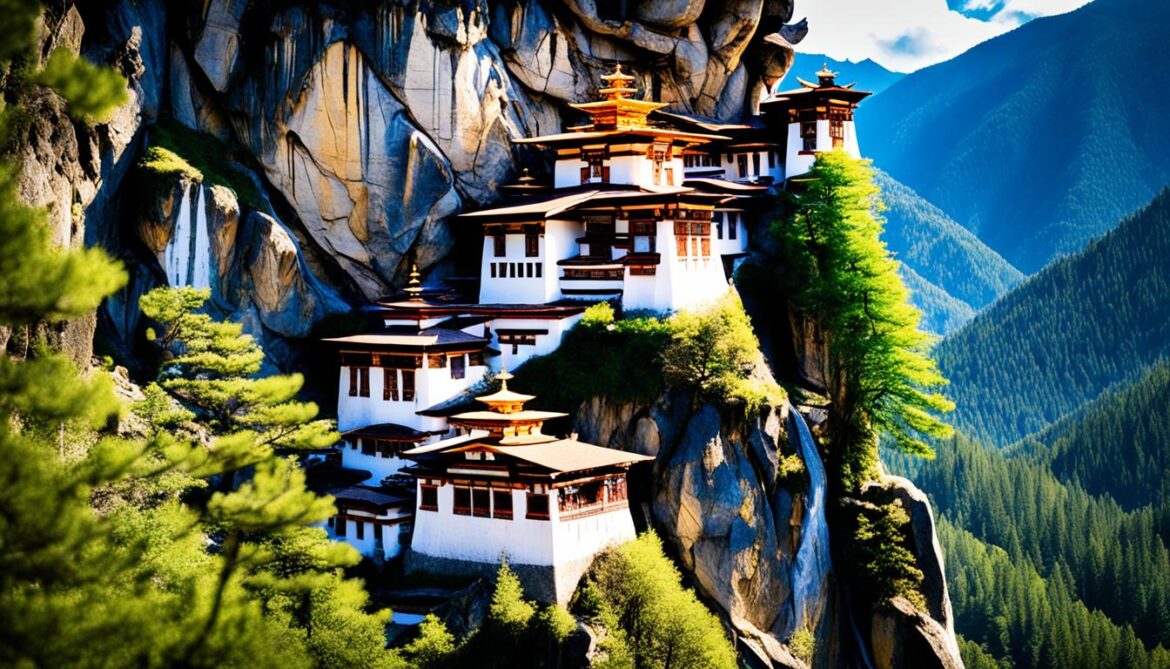
Through its unwavering commitment to sustainable development and biodiversity conservation, Bhutan sets an inspiring example for the world. By effectively managing its protected areas, integrating biodiversity targets, and safeguarding essential natural resources, Bhutan demonstrates the profound connection between environmental preservation, sustainable development, and the well-being of its people.
History of Green Building in Bhutan
Green building practices in Bhutan have a rich history rooted in the country’s cultural and spiritual beliefs. From ancient times, the construction of dzongs, fortress-like structures, exemplified early green building practices and architectural wisdom. These majestic edifices were designed to harmonize with the natural environment and reflect the country’s deep commitment to sustainability.
By integrating traditional knowledge and local materials, Bhutanese architects and builders crafted structures that seamlessly blended with the surrounding landscape. The intricate woodwork, meticulous stonework, and earth-toned colors paid homage to Bhutan’s cultural heritage while also embodying sustainable principles.
“The green building practices of Bhutan carry the essence of our cultural heritage. The dzongs, with their natural ventilation systems and utilization of sustainable materials, serve as a testament to our commitment to environmental stewardship.”
-Tashi Dorji, Architectural Preservationist
Today, Bhutan continues its legacy of green building practices by combining traditional wisdom with modern innovations. The country’s green building initiatives strive to preserve its unique cultural heritage while promoting sustainable development. By embracing eco-friendly architecture and incorporating sustainable design principles, Bhutan stands as a shining example of how a nation can blend modern progress with deep respect for its environment and cultural legacies.
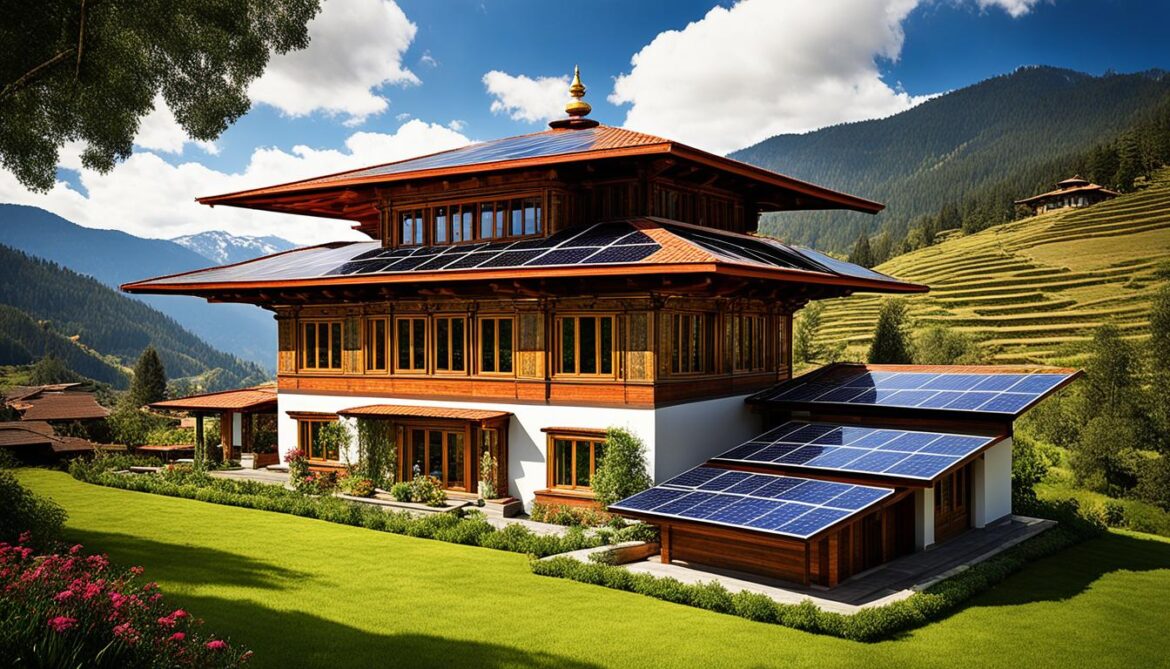
Preserving Cultural Heritage Through Green Building
Bhutan’s commitment to green building goes beyond environmental considerations; it also aims to safeguard the country’s rich cultural heritage. By integrating architectural practices that have stood the test of time, Bhutan maintains a harmonious balance between modernization and preservation.
The practice of constructing buildings using local materials not only reduces the carbon footprint but also preserves traditional craftsmanship and strengthens the local economy. Bhutanese artisans continue to employ ancient techniques, passed down through generations, to create sustainable structures that showcase the country’s architectural heritage.
- Integration of sustainable materials like rammed earth, bamboo, and locally sourced timber
- Utilization of passive design strategies for natural lighting and ventilation
- Building orientation that maximizes solar gain and minimizes heat loss
By combining sustainable principles and cultural preservation, Bhutan demonstrates that green building is not only about reducing environmental impact but also about honoring the past and ensuring a sustainable future.
Bhutan’s Green Building Initiatives
Bhutan is actively working towards a sustainable future through its green building initiatives. The country’s commitment to environmental conservation and sustainable development is reflected in its philosophy of Gross National Happiness (GNH). Bhutan focuses on integrating sustainability into its development plans, promoting eco-friendly architecture, and preserving its cultural heritage. Bhutan’s green building initiatives serve as a model for other nations aspiring to achieve environmental sustainability.
One of Bhutan’s key green building initiatives is the promotion of eco-friendly architecture. The country recognizes the importance of constructing buildings that minimize their impact on the environment. Bhutan’s sustainable architecture practices prioritize energy efficiency, waste reduction, and the use of renewable materials. By incorporating eco-friendly designs and technologies, Bhutan aims to reduce its carbon footprint and create buildings that harmonize with nature.
Bhutan’s green building initiatives also emphasize the preservation of its cultural heritage. The country takes pride in its traditional architecture, which blends seamlessly with the natural surroundings. Bhutan’s commitment to sustainable development includes the conservation of its unique architectural styles and construction techniques. By preserving its cultural heritage, Bhutan not only maintains its identity but also showcases the compatibility between traditional wisdom and modern sustainability.
A noteworthy aspect of Bhutan’s green building initiatives is the integration of sustainability into its development plans. The country recognizes that environmental conservation and sustainable practices go hand in hand with overall development. Bhutan’s sustainability efforts extend beyond individual buildings to include comprehensive urban planning strategies. By incorporating green spaces, promoting public transportation, and implementing energy-efficient infrastructure, Bhutan aims to create sustainable communities that prioritize the well-being of both people and the environment.
“Our green building initiatives align with our vision of Gross National Happiness, ensuring the well-being of our people and the conservation of our environment. Bhutan serves as a model nation for those who aspire to achieve sustainable development and environmental conservation.” – Prime Minister of Bhutan
Through its green building initiatives, Bhutan demonstrates its commitment to environmental conservation, sustainable development, and the well-being of its citizens. By prioritizing eco-friendly architecture, preserving cultural heritage, and integrating sustainability into development plans, Bhutan sets an example for other nations to follow. As a global leader in green building, Bhutan continues to inspire and pave the way towards a more sustainable future.
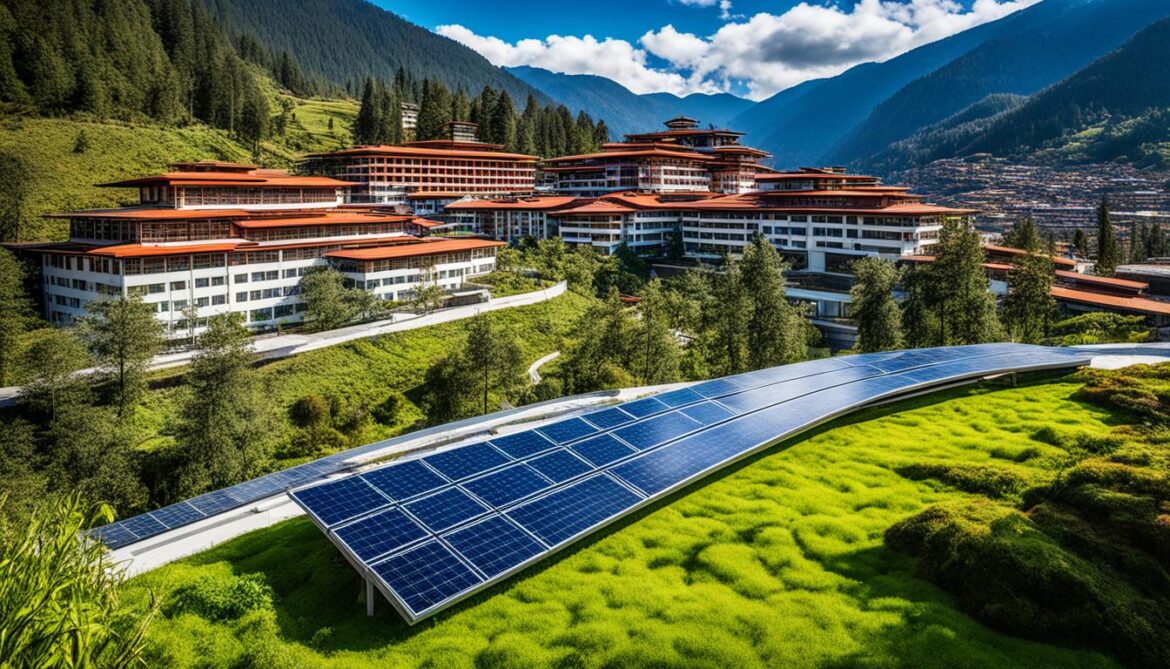
Biodiversity Action Plan for Bhutan
Bhutan, in its pursuit of sustainable development and conservation of its unique biodiversity, has developed a comprehensive Biodiversity Action Plan. This plan serves as a crucial guide, emphasizing the importance of maintaining the productivity, diversity, and integrity of Bhutan’s biodiversity and natural systems. By implementing direct actions, Bhutan aims to conserve and sustainably utilize both wild and domestic biodiversity resources.
The Biodiversity Action Plan recognizes the need for scientific research, surveys, monitoring, and databases to support Bhutan’s conservation efforts. It highlights the significance of gathering accurate data and knowledge to inform effective strategies and decision-making processes. By investing in research and monitoring initiatives, Bhutan can continually assess the status of its biodiversity and make informed conservation choices.
Furthermore, the Biodiversity Action Plan emphasizes the significance of stakeholder involvement and the integration of local knowledge and traditional practices. Bhutan recognizes that the active participation of communities, indigenous groups, and relevant stakeholders is essential for the successful implementation of biodiversity conservation initiatives. By engaging the local population and respecting their cultural values and perspectives, Bhutan ensures the sustainability and long-term success of its conservation efforts.
“The Biodiversity Action Plan underscores Bhutan’s commitment to sustainable development and its recognition of the intrinsic value of biodiversity for the well-being of its people and the planet.”
In line with its overall conservation strategy, the Biodiversity Action Plan sets clear goals and targets for the protection and sustainable use of Bhutan’s biodiversity. It provides a roadmap for the conservation, management, and restoration of habitats, species, and ecosystems. This strategic approach ensures that Bhutan’s efforts are focused and effectively address the threats posed to its biodiversity.
By implementing the Biodiversity Action Plan, Bhutan showcases its dedication to balancing economic development with environmental conservation. The plan aligns with Bhutan’s vision of Gross National Happiness (GNH), where sustainable development is integral to achieving the well-being and happiness of its citizens.
Key Components of Bhutan’s Biodiversity Action Plan
| Action | Description |
|---|---|
| 1. Protected Areas Management | Enhancing management effectiveness of protected areas, including expansion and improved connectivity |
| 2. Species Conservation | Focusing on the conservation and recovery of endangered and endemic species |
| 3. Habitat Restoration | Implementing measures to restore and regenerate degraded habitats |
| 4. Sustainable Use of Resources | Promoting sustainable practices for resource utilization, including responsible harvesting of wild biodiversity resources |
| 5. Climate Change Adaptation | Developing strategies and actions to mitigate the impacts of climate change on biodiversity |
| 6. Community Engagement | Involving local communities in biodiversity conservation through awareness programs and capacity building initiatives |
Through the implementation of the Biodiversity Action Plan, Bhutan reaffirms its commitment to its conservation strategy, supporting sustainable development while safeguarding its unique and precious biodiversity for future generations.

Challenges and Future Actions
Bhutan’s efforts in conserving its rich biodiversity are not without challenges. Limited funding and resources, along with a lack of research on smaller plant and insect species, pose significant obstacles to effective conservation. Additionally, the impact of climate change further exacerbates the difficulties faced by Bhutan in maintaining its unique ecosystems.
To address these challenges, Bhutan must prioritize scientific research and deepen its understanding of biodiversity. By conducting comprehensive studies on smaller plant and insect species, the country can gather valuable insights into these often-overlooked components of its ecosystems. This research can inform conservation strategies and provide a more holistic approach to protecting Bhutan’s biodiversity.
Furthermore, promoting sustainable practices, such as responsible land use and reducing carbon emissions, is crucial to safeguarding Bhutan’s fragile ecosystems. By integrating sustainable practices into various sectors, including agriculture, forestry, and urban planning, Bhutan can mitigate the negative impacts of development on its biodiversity.
By taking these actions, Bhutan will continue to lead the way in biodiversity protection and set an example for other nations facing similar challenges. Prioritizing scientific research and promoting sustainable practices are essential steps towards securing a sustainable future for Bhutan’s diverse ecosystems.
The Importance of Scientific Research
Scientific research plays a vital role in understanding and safeguarding Bhutan’s biodiversity. By studying the various species and ecosystems, researchers can identify potential threats and develop targeted conservation strategies. From assessing the impact of climate change to monitoring population dynamics, scientific research provides valuable insights for informed decision-making.
“Scientific research is crucial in guiding our conservation efforts. It helps us understand the complex interactions within ecosystems and enables us to make evidence-based decisions to protect our biodiversity.” – Dr. Tshering Dhendup, Wildlife Biologist
Challenges, Research, and Conservation Efforts: A Delicate Balance
Bhutan’s commitment to biodiversity conservation is commendable; however, the challenges it faces require a delicate balance between research and conservation efforts. Limited resources necessitate strategic allocation to maximize the effectiveness of both endeavors. By prioritizing scientific research and utilizing conservation strategies informed by data, Bhutan can overcome these challenges and make significant progress in protecting its unique biodiversity.
Bhutan’s Conservation Efforts in Numbers
| Protected Areas | Total Land Area | Species Count |
|---|---|---|
| 42% | Approximately 24,000 square miles | Over 6,500 plant species, including 46 threatened species |
The table above demonstrates Bhutan’s commitment to conservation through the establishment of protected areas, covering 42% of the country’s land area. These protected areas provide crucial habitats for a diverse range of plant and animal species. With over 6,500 plant species, including 46 threatened species, Bhutan’s conservation efforts have made a significant impact in safeguarding its unique biodiversity.

By combining scientific research, strategic funding, and sustainable practices, Bhutan can overcome the challenges it faces in conserving its biodiversity. The country’s commitment to preserving its natural heritage sets an example for other nations striving for sustainability and underscores the importance of collective efforts in protecting our planet’s precious ecosystems.
Benefits of Bhutan’s Biodiversity
Bhutan’s rich biodiversity provides numerous benefits, including ecosystem services, economic opportunities, and cultural value. The country’s intact ecosystems contribute to climate regulation, water purification, soil conservation, and disaster mitigation. Bhutan’s biodiversity also supports tourism and ecotourism, providing economic opportunities for local communities. Furthermore, Bhutan’s biodiversity is integral to its cultural heritage, as it is deeply intertwined with religious and spiritual practices.
| Biodiversity Benefits | Description |
|---|---|
| Ecosystem Services | Bhutan’s biodiversity plays a crucial role in maintaining ecosystem services such as carbon sequestration, nutrient cycling, and pollination. These services are essential for the overall functioning and health of the environment. |
| Economic Opportunities | The diverse flora and fauna of Bhutan attract tourists, nature enthusiasts, and researchers from around the world. This creates economic opportunities through tourism, research, and the sale of sustainably harvested natural resources. |
| Cultural Value | Bhutan has a deep cultural and spiritual connection to its biodiversity. The country’s traditional practices and beliefs are intertwined with the natural environment, making biodiversity an essential element of Bhutan’s cultural heritage. |
Overall, Bhutan’s biodiversity provides a range of benefits that contribute to the country’s sustainable development and conservation efforts.
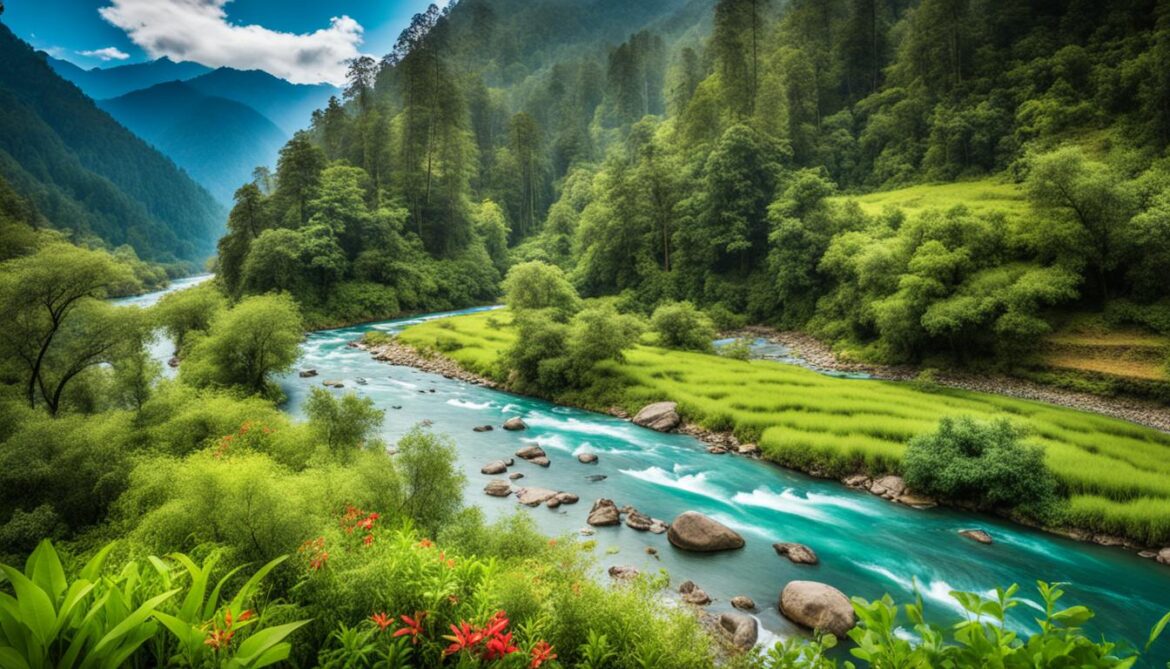
Conclusion
Bhutan’s commitment to biodiversity conservation and sustainable development is commendable. The country’s proactive initiatives and strategies demonstrate its dedication to preserving its rich biodiversity and diverse ecosystems. By implementing effective conservation measures, Bhutan can ensure the continued existence of its unique flora and fauna for future generations.
Scientific research plays a vital role in understanding and protecting Bhutan’s biodiversity. By prioritizing research efforts, Bhutan can gain valuable insights into the intricate relationships between species, ecosystems, and the environment. This knowledge will inform conservation strategies and enable the country to better address the challenges it faces.
Furthermore, Bhutan serves as a model for global conservation efforts. Its emphasis on sustainable practices, integrated with its cultural heritage, sets an example for other nations. Bhutan’s success in balancing economic development with environmental preservation offers valuable lessons in achieving a harmonious and sustainable future.
In conclusion, Bhutan’s dedication to biodiversity conservation and sustainable development positions it as a leader in global environmental efforts. By continuing to prioritize conservation measures, invest in scientific research, and promote sustainable practices, Bhutan can continue to protect its unique biodiversity and inspire the world to follow suit.
FAQ
What is the biodiversity like in Bhutan?
Bhutan is known for its diverse ecosystems and abundant flora and fauna. It is home to over 5,600 species of flowering plants, close to 200 species of mammals, and 678 bird species.
What are the threats to Bhutan’s biodiversity?
Bhutan’s biodiversity faces threats from land conversion, overexploitation of resources, climate change, and forest fires.
What conservation efforts are in place in Bhutan?
Bhutan has implemented various conservation measures and established protected areas, with over 42% of the country’s land being designated as protected areas.
How does Bhutan promote green building practices?
Bhutan promotes green building practices by preserving its cultural heritage, integrating sustainability into development plans, and promoting eco-friendly architecture.
What is Bhutan’s Biodiversity Action Plan?
Bhutan has developed a Biodiversity Action Plan that guides its conservation efforts and sustainable development, emphasizing the importance of maintaining the productivity, diversity, and integrity of its biodiversity.
What are the challenges faced in conserving Bhutan’s biodiversity?
Bhutan faces challenges such as limited funding and resources, a lack of research on smaller plant and insect species, and the impact of climate change. Prioritizing scientific research and promoting sustainable practices can help address these challenges.
What are the benefits of Bhutan’s biodiversity?
Bhutan’s rich biodiversity provides ecosystem services, economic opportunities, and cultural value. It contributes to climate regulation, water purification, soil conservation, and supports tourism and ecotourism.
How does Bhutan incorporate sustainability into its development plans?
Bhutan incorporates sustainability into its development plans by integrating biodiversity targets, promoting sustainable practices, and aligning national targets with international conventions.
How does Bhutan’s commitment to biodiversity conservation reflect in its initiatives?
Bhutan’s commitment to biodiversity conservation is evident in its proactive initiatives, such as the establishment of protected areas, controlling the unsustainable harvesting of medicinal plants, and conserving tiger populations.



